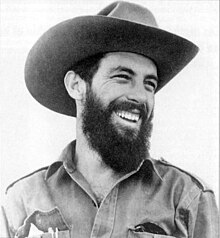Camilo Cienfuegos | |
|---|---|
 Camilo Cienfuegos (c. 1959) | |
| Commander-in-chief of the Revolutionary Armed Forces | |
| In office 3 January 1959 – 28 October 1959 | |
| President | Manuel Urrutia |
| Prime Minister | Fidel Castro |
| Personal details | |
| Born | Camilo Cienfuegos Gorriarán 6 February 1932 Havana, Cuba |
| Died | 28 October 1959 (aged 27) Straits of Florida (presumed) |
| Cause of death | Aviation accident (presumed) |
| Resting place | North Atlantic Ocean (presumed) |
| Political party | 26th of July Movement |
| Relatives | Osmany Cienfuegos (brother) |
| Alma mater | Academia Nacional de Bellas Artes San Alejandro |
| Military service | |
| Allegiance | Cuba |
| Branch/service | Revolutionary Armed Forces |
| Rank | Major |
| Battles/wars | Cuban Revolution |
Camilo Cienfuegos Gorriarán[a] (Spanish: [kaˈmilo sjeɱˈfweɣos ɣorjaˈɾan]; 6 February 1932 – 28 October 1959) was a Cuban revolutionary. One of the major figures of the Cuban Revolution, he was considered second only to Fidel Castro among the revolutionary leadership.
The son of Spanish anarchists, Cienfuegos engaged with left-wing politics from an early age, going on to join the opposition movement against the dictatorship of Fulgencio Batista. He joined Castro's 26th of July Movement on its expedition to Cuba and was one of the few survivors of the Landing of the Granma. He quickly distinguished himself as one of the top commanders of the Cuban Revolutionary Armed Forces and a popular leading figure of the revolution, becoming close friends with Che Guevara during their guerrilla campaign in Las Villas. After winning the Battle of Yaguajay in December 1958, Cienfuegos led the capture of Matanzas and Havana, where he was appointed as commander-in-chief of the armed forces by the new revolutionary government. He oversaw the reorganization of the armed forces, in order to purge leading figures of the Cuban National Army and replace them with guerrilla commanders more loyal to Fidel Castro.
When Huber Matos objected to Castro's consolidation of power, he was arrested by Cienfuegos. While flying back from Matos' former headquarters at Camagüey, Cienfuegos' plane disappeared over the Straits of Florida. After a few days of an attempted search and rescue operation, he was presumed dead by the Cuban government. His disappearance quickly spawned a number of conspiracy theories, many of which speculated Fidel or Raúl Castro to have been responsible, but no proof of such has been discovered. Cienfuegos has since become known as a revolutionary martyr in Cuba, with a number of institutions being dedicated to his name, including a Military Schools System and an Order of Merit.
Cienfuegos was a popular figure in Cuba, due to his cheerful and carefree personality, which contrasted sharply with the strict austerity of his comrade Guevara. Although he was claimed by different factions to have been a communist, an anti-communist or an anarchist, he never publicly expressed any political ideology. The soldiers that fought for him remembered him for his friendly and paternal leadership style, while the Cuban government upheld him as a loyal supporter of Fidel Castro. Every year, on 28 October, Cuban children throw flowers into the rivers and seas, in tribute to him.
Cite error: There are <ref group=lower-alpha> tags or {{efn}} templates on this page, but the references will not show without a {{reflist|group=lower-alpha}} template or {{notelist}} template (see the help page).